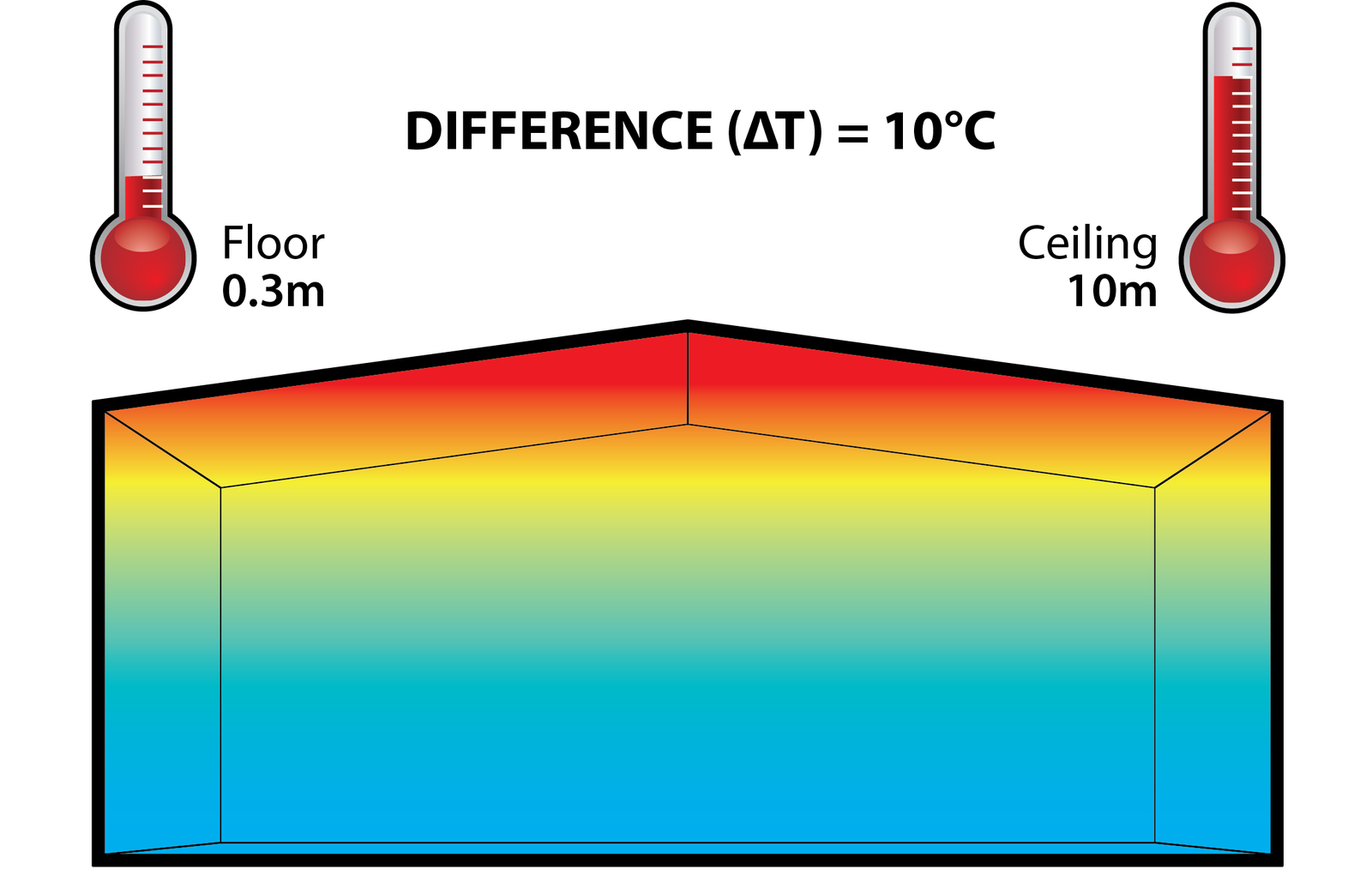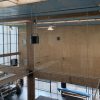
How to stop your heating costs going through the roof? Literally…
Find out here how destratification can send your heating bills (and your heat) back down to the floor, where they belong.
I had a client say the other day they had never heard of destratification, so why would they use it?
‘Quite simple’, I replied.
‘To save significant amounts of heating energy AND make your customers more comfortable’.
When I showed her the heating energy savings figures and Returns on Investment (ROI) or payback terms, from numerous projects around the world, where building owners are using destratification, and the broad range of testimonials on how much more comfortable the space is in winter because of destratification, she was very impressed and is now going to destratify her facilities. Common sense prevailed.
Now for those who aren’t aware, stratification is the layers of temperature you find inside a building at any time of the year. Cold air is denser than warm air, so the cold air falls and pushes the warm air upwards, towards the roof.
You now have a stratified space. Usually there will be around 0.5-1.5 Deg.C of stratification per vertical metre in winter. So, if you have an 8 metres space you may have 5-12 degrees temperature difference in your building from floor to ceiling or roof. In an open space we measured recently here in Australia, there was a difference of 5 Deg. C. floor to ceiling over 5 metres! That’s a lot of stratification in a not very high space, but typical of many facilities.
So, if you are trying to achieve a more comfortable 22 Deg. C at 1.5 metres above FFL, then in a 6 metre high space you may have, for example, 29 Deg. C. at roof level. That’s 7 Deg. C difference. At an average of 6-8% of energy consumption per degree of wasted heat, right there you have 42% of your heating bill being wasted!

(Chart no 1: -Graphic detailing stratification and then destratification and the change in temperature it brings to a space.)
It’s all sitting up under the ceiling. (See chart above)
Doing nothing for your comfort!
In a larger space, that stratification results in even more money being spent. For zero value! Simply wasted dollars.
I find it intriguing how here in Australia destratification is not utilised more as a simple ‘go to’ solution for saving energy and improving comfort in all types of buildings. It’s such a simple, low cost, fast payback solution in many cases.
If you contact an energy auditing company for example, I guarantee only one or two will provide the destratification solution as part of their energy saving armoury.
Certainly, in Australia, the more prevalent and documented Airius projects are using our air movement technology to move large volumes of air for cooling. We have successfully created that market here.
However, overseas, in UK, Europe, USA, Canada, Airius Air Pears are used for heating and also cooling. Massive and measurable energy savings in heating are achieved by all of our customers who have implemented destratification.
Sometimes they are saving up to 60% of their heating bill. 60%!
With paybacks of less than three months (e.g: Lush Cosmetics, Poole, South West England – See Case Study Here)
Destratification is usually a simple retrofit and, in new buildings, an even simpler install. Thereby making it a very cost effective and unobtrusive methodology to reduce costs. It’s a similar cost to installing a high-bay light.
Sure; I get we aren’t as cold in winter as many of the overseas countries achieving great success with destratification, but if you have heating costs, then you are still spending a lot of money paying for heat that you are generating to sit up under the roof or ceiling, where it is not needed.
Doesn’t matter where you reside, hot air rises. And your heating methodology is keeping it up there.

(Chart no 2: -Typical destratification energy savings at different heights and different stratification levels.)
Even if it’s only a three-month heating cycle, then for three months you are wasting from between 10-50% of your energy bill.
Now certainly, the higher the space the more heat (or stratification) you will have sitting up under your roof, where it is not needed.
But even in spaces of 4 metres high, or less if you have specific temperature requirements, (Watson and Sons, Honey producers in NZ had stratification of 12 Degrees C in a 4-metre-high space) then the use of destratification will quickly and easily rectify your issue and start saving you dollars. Usually lots of them.
For example, here in Australia, The Axeman’s Hall of Fame in Tasmania, (a museum that has been in business for over 20 years) turned 60% of their heating off just 2 days after installing Airius Air Pears in 2014. They installed only 4 x Airius Model 25 Air Pears into their 340 sq. metres, 8-metre-high space. Yes, 60%!
Plus, their customers advised they had never experienced thermal comfort like it in the space after the install of such a small number of Airius Air Pears.
Estimated ROI in that facility was 6 months!
Another industry group that is achieving superior benefits from destratification is the major supermarket chains here in Australia and NZ. They are now realising the thermal comfort benefits of destratification in their cold aisles (equalling increased dwell time and resultant sales) and in other parts of their stores, as their counterparts in UK, Europe and the USA have been doing for a decade.
In addition, the expansion of the destratifications units into the other parts of their stores will provide energy savings and improved balance of temperatures and comfort throughout the store.
So why the lack of adoption of this simple but very effective technology in Australia?
There are no doubt myriad reasons for that and many I don’t profess to know the answer to.
I’m sure a key impediment to adoption of destratification is quite simple. Enough people aren’t aware of the value of it.
I’m sure most building owners or facility managers, who pay for the operational bills such as heating costs, don’t know of or fully grasp the value of destratification. It’s a fantastic opportunity being missed.
You would have to think they would utilise it once they knew about it, as the physics are very simple and obvious.
Also, as mentioned earlier, there are numerous energy savings companies that don’t understand or know of the intrinsic value this type of detail, who could introduce destratification to their energy savings product portfolio.
Really, if you are selling energy savings to your client and don’t identify destratification in winter as a major cost saving initiative, then are you offering your clients their best options or a complete solution?
Just installing destratification into your facility will usually lead to being able to turn your heating thermostat down by 2-3 degrees if not more. Right there that’s a massive saving.
In our discussions with consulting engineers around Australia, many understand stratification but maybe they don’t fully grasp the simple cost benefit achieved by the use of effective destratification, possibly resulting in some impediment to specification.
That’s the key…the simple cost/benefit equation.
Everyone always reaches for LED lights and changes to A/C equipment as an energy saving replacement strategy. They are typically the first points of call.
Alternatively, there are many consulting engineers here in Australia who fully understand the benefits of implementing destratification and they have successfully guided their projects towards the use of Airius products, with great success.
And of course, in some climates here in Australia, there is not the demand for heating so therefore heating is simply not an issue for those facility owners.
Regarding costs, if we take the upfront costs of installing Airius destratification/ circulation fans, in a new build its around $200-$300 per unit and in an existing building it is subject to access due to height or building envelope and also operational timing etc.
But it can range in existing facilities from $250 -600 per unit on average.
If you then consider the cost of say an effective destratification fan such as an Airius unit for an 8-metre-high 800 sq. metres space, (for destratification use only) it’s often around $6-12 per sq. metres supplied and installed.
‘Return on Investment’, the often-cited prerequisite for an investment to be approved, can be a significant win for the destratified space owner.
In the UK, for example, some clients have experienced a ROI of 3 months (Lush Cosmetics) and in other parts of the world, the destratification ROI can vary between 6-60 months.
Usually, however, it’s a 6-30 months Payback.
If you add in support from governments for carbon and energy reducing programmes (ESCII,VEEC etc) found across Australia, your ROI can be reduced even more.
In regions such as South Australia, ACT, Victoria and Tasmania, often the cost of heating bills is higher than the cost of cooling bills. (www.sa.gov.au/topics/energy-and-environment/using-saving-energy/calculate-running-costs)
So it’s a fantastic opportunity not being utilised.
Professor Byron Jones, from Kansas State university in the USA, in his energy efficiency research, said…
‘Destratification is the single largest waste of energy in buildings today’
Certainly, parts of NSW, such as Cooma, Wagga, Orange, Tamworth or Armidale and all other areas west of the coastal dividing range right down to Victoria, and right up to Mt Isa in QLD, (any area with high winter diurnal ranges) and the zone south of the line from Sydney right across to Perth, experience extremely cold temperatures in winter, in some cases, of down to -10 Deg C.
And, of course, Alice Springs and those central Australian areas, can, in winter, experience very cold nights due to the lack of cloud cover.
This all raises the question, should we be giving destratification much more Kudos than we currently do here in Australia?
When you consider destratification you need to, however, understand the physics of air movement and thrust etc, and the value of destratifying at floor level and not at the fan nozzle.
Worldwide there are assorted attempts at destratification fans plus there are air conditioning register designs used to distribute warm air but they all have the same issue. They can’t force the lighter warm air down through the denser cold air sitting at the floor.
They don’t have the thrust.
Which is why there are thousands of air-conditioned or heated buildings using typical duct layouts, or under floor heating, package units etc or simple hydronic heating solutions, that still have to (or should) install destratification fans to make that warm air get back to the floor. Standard and typical air delivery methodologies aren’t effective in that application.
One of the tricks to effective destratification is the ability to move air gently, so as not to cause a draft, but ensure there is enough thrust to penetrate the cooler denser layers at floor level with the warmer, lighter air. This results in mixing, or destratifying at floor level, where it’s needed, not at higher level like other fan types.
That mixing is key to the efficacy of a destratification solution.
There are numerous types of fans available on the market and some claim to be destratification fans but their biggest problem is that some of them mix air, at the fan, but they can’t move it very far. Due to their lack of a turbine design and resulting poor air flow shape and lack of thrust, their air delivery will just hit the cold air and spread horizontally, significantly impairing its performance and resulting in very poor actual destratification.
Certainly, large blade HVLS fans have achieved good results in destratification, however they come with a range of constraints and consequential costs such as: –
- Three phase power requirements
- Strobing of lighting
- Structural requirements
- Impingements on operational needs such as overhead cranes or basketballs
- Poor ability to move air down between aisles
- Ongoing maintenance contracts
- High redundancy levels in big spaces due to the small number of fans used.
As you would know from our previous newsletters over the summer periods, Airius has great success providing cooling using their units, simply by moving large volumes of air around the space, like a typical fan does, but using vastly different technology and form.
For destratification, Airius simply use either their smaller fans spaced further apart, or, if you need summer cooling as well, we design for the summer aspect but run the units at a much lower speed in winter to achieve your required destratification results. Simple.
The other, and less well-known key component of destratification is that if implemented, it will significantly reduce the loss of heat through your roof during winter as the temperature difference between indoors and outdoors at roof and ceiling levels, after destratification, is much less, resulting in a much lower rate of heat transfer/loss out of your roof. Even with high ‘U’ or ‘R’ values of insulation, that rate of heat transfer is significantly slowed down post destratification.
If you combined that benefit with the numerous other benefits of destratification including, primarily the energy saving outcomes from reducing the overheating in your space and much improved thermal comfort in the habitable zone, then the use of destratification fans in winter offers significant, fast payback and optimised internal built environment, which are usually a key desire for a building owner or user.
In addition, if building owners and consultants are serious about the swing to sustainable or green buildings, then maybe there should be a default implementation of destratification across many Australian climates as part of the standard energy efficient or green building design.
That’s a story for another newsletter though.
If you are a building owner, engineer, architect, designer or facility manager and want to find out more about how the unique Airius® Air Pears can simply and quickly reduce your ongoing heating bills, and make your building users more comfortable, contact us today or send us your plans and we can easily put together a proven cost-effective solution.
That’s what we do.
John Brodie, MSc (Sus Des) U Syd
Director, Airius Australia







